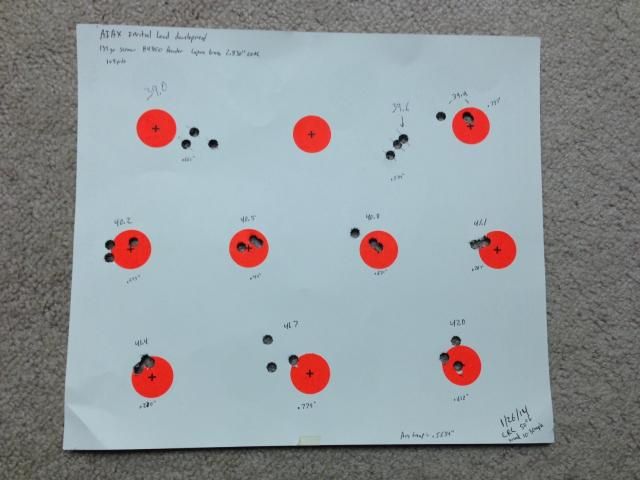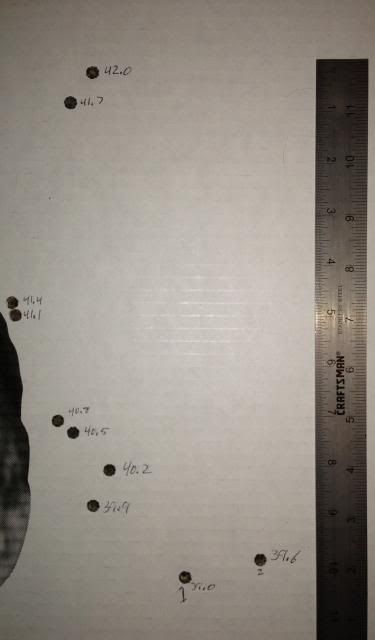I'm working on load development for my new AIAX .260 Rem. Currently using:
139gr Scenar bullets
H4350 powder
Lapua brass
Winchester primers.
I'm trying to be economical with components right now, since they're a bit hard to find, and did my initial testing with 5-rounds of 10 different charge weights between 39.0gr and 42.0gr of powder (which is the listed max load in my book). With the exception of the lowest charge interval (which jumped from 39.0-39.6 grains) I used a 0.3 grain charge weight increment for this testing.
Here's how the groups turned out (shot from 109 yards) in VERY windy conditions. Based on these shots it looks like there might be an accuracy node in the area around 41.1-41.4 grains of powder. It's also possible that I shanked a few shots because I was quite cold and wind-battered by the end of this test (started reasonably warm, and the bottom just fell out of the weather that day):

I then went out today and shot a ladder test using this same ammo at 500 yards, in relatively calm conditions. Once again it looks like the only possible node I see is sitting around that 41.1-41.4 grain charge weight (save for the starting charge, which is way too slow).

Some chronograph results over a Magnetospeed (the day I shot the 3-shot groups) gave me the following velocities:
39.0 2545fps Group size: .660"
39.6 2557fps Group size: .534"
39.9 2568fps Group size: .737"
40.2 2594fps Group size: .673"
40.5 2623fps Group size: .411"
40.8 2683fps Group size: .671"
41.1 2692fps Group size: .287"
41.4 2708fps Group size: .270"
41.7 2723fps Group size: .779"
42.0 2738fps Group size: .612"
Based on the limited data I have thus far, it seems like I should start examining the area between around 41.0 and 41.5 grains of H4350. The thing is, in other rifles I've usually found a "node" consisting of at least three charge weights that cluster together, whereas I only have two charge weights looking similar within my testing (that could just be plain dumb luck, too). I'm also noticing that my velocity is only sitting around 2,700 fps, which is about 150fps slower than I was hoping to develop. I've got NO pressure signs at my max load of 42.0 grains, and I know a lot of guys go hotter than 42.0 grains of H4350 while using this bullet (historically I've not been one to exceed the max charge weights listed in my load data though). I should also mention that I haven't really done anything with seating depth yet, and I've got a lot of room to move the bullet forward still.
So, here are the options I see:
1) Shoot another ladder test and some more groups to see if my results repeat on the next go around.
2) Start examining the possible node I've discovered so far, and settle for a moderate load of approx. 2,700 fps.
3) Carefully increase my load to see if I can find a faster node above the maximum I've loaded so far.
Where would you go from here?
139gr Scenar bullets
H4350 powder
Lapua brass
Winchester primers.
I'm trying to be economical with components right now, since they're a bit hard to find, and did my initial testing with 5-rounds of 10 different charge weights between 39.0gr and 42.0gr of powder (which is the listed max load in my book). With the exception of the lowest charge interval (which jumped from 39.0-39.6 grains) I used a 0.3 grain charge weight increment for this testing.
Here's how the groups turned out (shot from 109 yards) in VERY windy conditions. Based on these shots it looks like there might be an accuracy node in the area around 41.1-41.4 grains of powder. It's also possible that I shanked a few shots because I was quite cold and wind-battered by the end of this test (started reasonably warm, and the bottom just fell out of the weather that day):

I then went out today and shot a ladder test using this same ammo at 500 yards, in relatively calm conditions. Once again it looks like the only possible node I see is sitting around that 41.1-41.4 grain charge weight (save for the starting charge, which is way too slow).

Some chronograph results over a Magnetospeed (the day I shot the 3-shot groups) gave me the following velocities:
39.0 2545fps Group size: .660"
39.6 2557fps Group size: .534"
39.9 2568fps Group size: .737"
40.2 2594fps Group size: .673"
40.5 2623fps Group size: .411"
40.8 2683fps Group size: .671"
41.1 2692fps Group size: .287"
41.4 2708fps Group size: .270"
41.7 2723fps Group size: .779"
42.0 2738fps Group size: .612"
Based on the limited data I have thus far, it seems like I should start examining the area between around 41.0 and 41.5 grains of H4350. The thing is, in other rifles I've usually found a "node" consisting of at least three charge weights that cluster together, whereas I only have two charge weights looking similar within my testing (that could just be plain dumb luck, too). I'm also noticing that my velocity is only sitting around 2,700 fps, which is about 150fps slower than I was hoping to develop. I've got NO pressure signs at my max load of 42.0 grains, and I know a lot of guys go hotter than 42.0 grains of H4350 while using this bullet (historically I've not been one to exceed the max charge weights listed in my load data though). I should also mention that I haven't really done anything with seating depth yet, and I've got a lot of room to move the bullet forward still.
So, here are the options I see:
1) Shoot another ladder test and some more groups to see if my results repeat on the next go around.
2) Start examining the possible node I've discovered so far, and settle for a moderate load of approx. 2,700 fps.
3) Carefully increase my load to see if I can find a faster node above the maximum I've loaded so far.
Where would you go from here?
Last edited:
